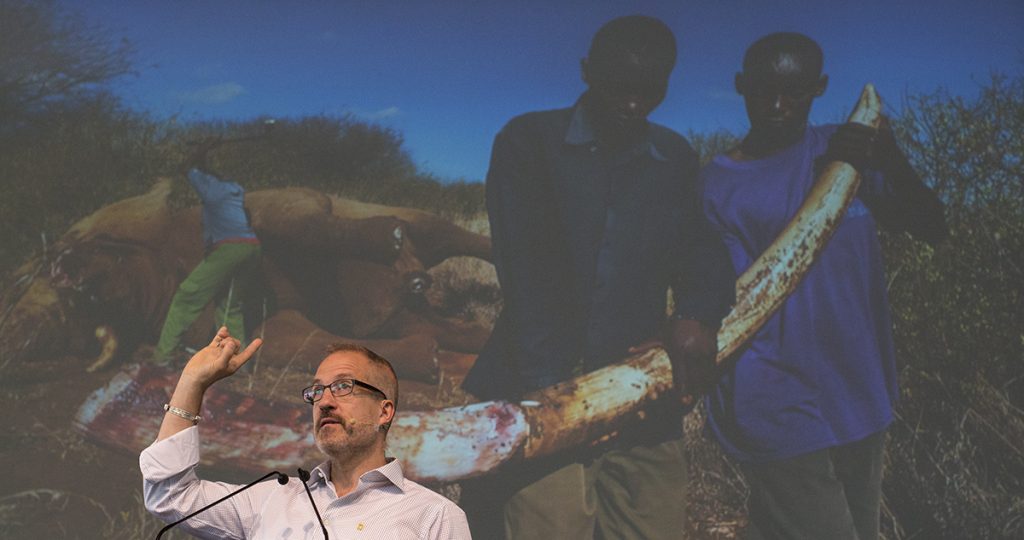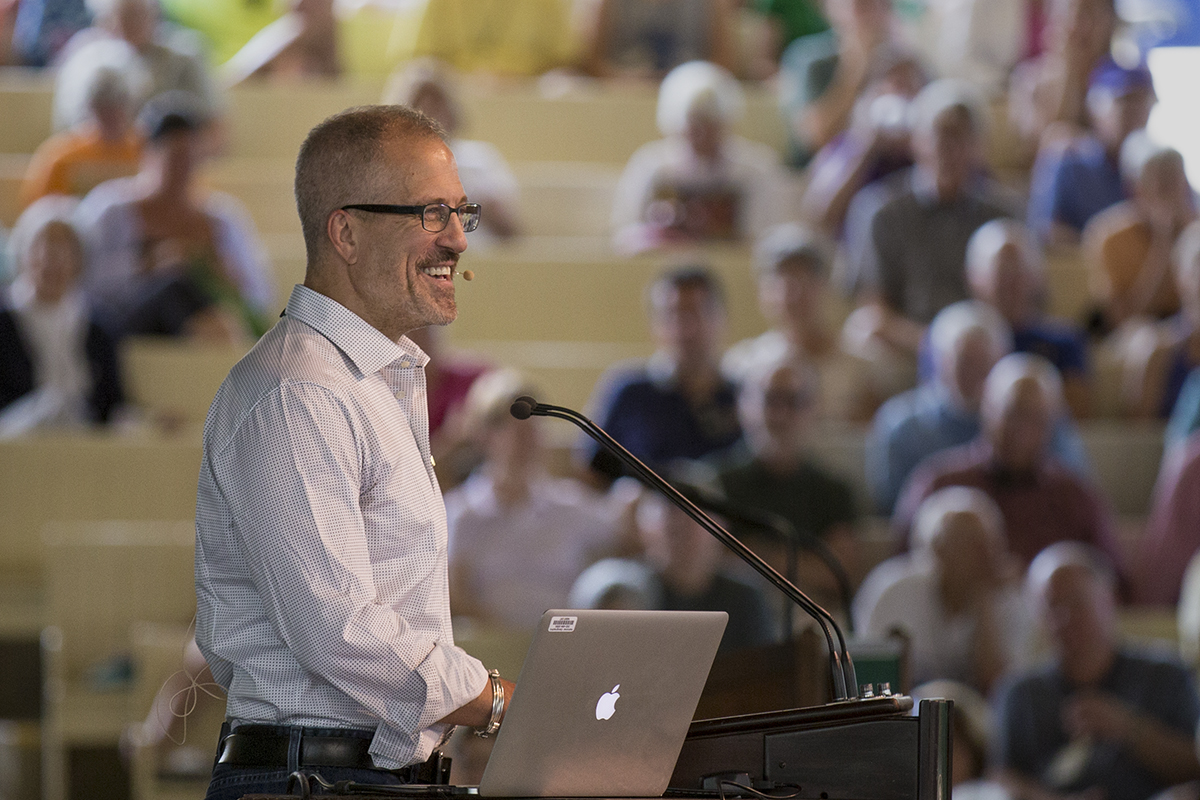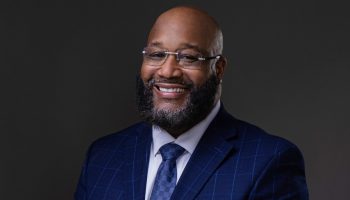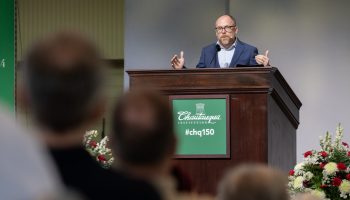Nearly 30,000 elephants are slaughtered every year. Elephants die to make cutlery handles, religious sculptures, piano keys, billiard balls and more — all out of the ivory of their tusks.
As founder of the Special Investigations Unit at National Geographic, Bryan Christy is known for his writing on international wildlife trafficking. He spoke about his experiences advocating for elephant protection and his investigation of the ivory trade during the July 29 morning lecture in Amphitheater.
“Elephants are being killed in every way imaginable,” Christy said. “I wanted to do something about that. I am not your classic National Geographic explorer. I’m not a biologist. I’m not a scientist. I’m not an engineer. I don’t have many talents, really, but I do like animals.”
Christy said common ways to poach elephants include shooting them with an AK-47, digging large pits for them to fall into or poisoning their watering hole.
Poaching became a worldwide issue in the 1970s. The elephant population numbered 1.2 million, but by the end of the decade, half of Africa’s elephants were killed for the ivory industry. In East Africa, Kenya noticed this swift decline in elephants and decided to take action.
Kenya’s president Daniel arap Moi set fire to the country’s collection of ivory, and the world took notice. Christy said it “galvanized the world” as other countries wondered whether they should protect the elephants or continue the ivory industry.
The world followed in Kenya’s footsteps, and President George H. W. Bush banned the import of ivory into the United States.
However, the ivory trade made a comeback in 1997 when South African countries decided their elephant population was strong enough to begin poaching them. These countries wanted to use the valuable ivory to help their economy.
In 1999, 50 tons of elephant tusks were shipped to Japan; in 2008, 102 tons of ivory were shipped to Japan and China. Both of these countries have historical backgrounds in ivory carving. Many of these carvings are religious-based.
“That changed everything,” Christy said. “Elephants today are under siege. Since 2008, poaching across Africa has escalated.”
The Chinese and Japanese governments had the choice between the ivory religious sculptures and the African elephants. These countries have no close connection to the elephants, Christy said, and that led to a lack of understanding and caring.
Christy pursued a story about ivory trafficking and the religious link to the trade. The story ran on the cover of National Geographic in October 2012, titled “Bloody Ivory: Ivory Worship.”
Though religion was not the main driving force behind the ivory industry, it brought a new issue to light. As a result, Cardinal Ricardo Vidal of Cebu tried to ban Christy, declaring him “persona non grata.” In the article, Christy also exposed Vidal’s colleague Monsignor Cristobal Garcia as an ivory collector and pedophile.
“Nobody has, sort of, pulled back the curtain on religion’s role,” Christy said. “I put both of those elements in this story because I knew that I could make a difference with this narrative, and it did.”
Garcia was stripped of his title and removed from the church. Christy was invited back to the Philippines six months later to be the keynote speaker at the first ivory destruction ceremony to take place in a non-African country.

“This is the power of narrative,” Christy said. “It’s the power of storytelling. It’s the power of harnessing what generally is told as a victim story. There is [the] power to make a difference locked inside these terrible stories.”
Christy said he took the issue of ivory trafficking and made it a crime story, something he was able to do with his background in law and general interest in crime. Instead of writing a sad story about mass elephant deaths, Christy wanted to invigorate people and stir up anger that would lead to change.
“Stories like this empower other actors in the ecosystem that make a difference,” Christy said, and this destruction of ivory in the Philippines was reenacted around the world.
In 2012, then-Secretary of State Hillary Clinton led a roundtable discussion about wildlife trafficking. In 2015, the Presidential Task Force on Combating Wildlife Trafficking was created under President Barack Obama.
“I’ve come to understand that telling wildlife crime stories isn’t about wildlife anymore, not for me,” Christy said. “We can use wildlife stories and crime stories to tell bigger social stories, to expose social problems that we couldn’t get to.”
Christy also talked about his idea to create an authentic-looking elephant tusk with a GPS satellite to track the movement of ivory in Central Africa. Christy partnered with George Dante, a well-known taxidermist, to create a synthetic ivory tusk that looked and felt real.
“My idea was, if this were a drug trafficking syndicate I was going after, I would plant a tracker inside a suitcase of cocaine if I could,” Christy said. “This plan had a small hitch.”
Dante was successful in creating this fake ivory tusk, so successful Christy was arrested when the tusks were seen during an X-ray of his luggage at the Dar es Salaam’s international airport in Tanzania. When his luggage was checked after a suspicious shape showing up in his suitcase, it appeared Christy was smuggling in an elephant tusk worth thousands of dollars on the black market.
Filmmaker J.J. Kelley accompanied Christy on his journey and caught the ordeal on his iPhone camera, which he positioned in his shirt pocket. The arrest aired as an episode of “National Geographic Explorer.”
Christy discovered his fake ivory went north to Sudan after it entered the black market in Central Africa. It ended up in the same area where Christy previously interviewed people from the Lord’s Resistance Army led by Joseph Kony.
“This story was important to me because it showed the face of terrorism in the ivory game, and it also gave cover to China,” Christy said.
China faced a political decision when it came to their ivory trade because of the deeply rooted history of ivory carvings. However, the reveal of terrorism as the driving force behind ivory trafficking allowed China to see the issue was not cultural, and Chinese diplomats wanted to support acts against terrorism, Christy said.
In 2008, China was authorized to build the largest ivory carving factory in the world; seven years later Chinese President Xi Jinping promised to stop the commercial trade of ivory.
“It can make all the difference for elephants,” Christy said. “I do my work to honor these animals and these ecosystems.”





